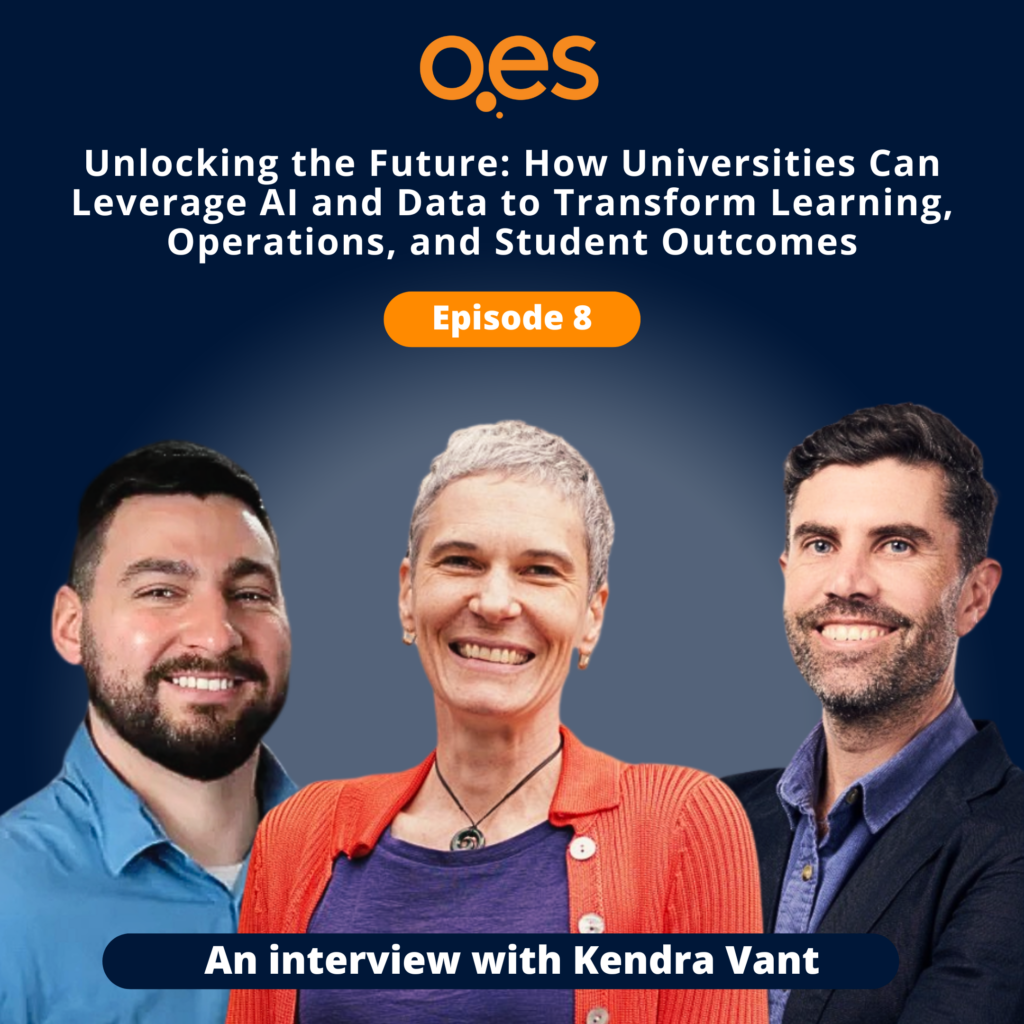Highlights from Episode 8 of The Thought Bubble Podcast by OES

Artificial intelligence (AI) is transforming many sectors, and higher education is no exception.
As universities explore the potential of AI, it’s crucial to understand both the opportunities and challenges this technology presents.
In a recent episode of The Thought Bubble podcast by OES, AI and data expert, Dr Kendra Vant, shared her insights into how universities can leverage AI in 2025 and beyond to enhance teaching practices, learning outcomes, and research – while maintaining awareness of, and ability to navigate the tech’s limitations.
Dr Kendra Vant is highly respected and trusted across multiple sectors for her considerable knowledge and understanding of data and AI.
An MIT graduate with a PhD in Physics, Kendra is currently the Director of Europa Labs, an organisation committed to helping organisations build value through the data they collect.
Kendra holds many roles with broad experience across sectors, including as an advisor to Air Tree, one of the biggest venture capital firms in Australasia. She’s also a non-executive director at disability support organisation InLife; And, she blogs on all things data and AI on her popular Substack, ‘Data Runs Deep‘.
And on top of that, she’s a member of the National Data Advisory Council, a Mentor at Creative Destruction Lab, and has held many senior roles at companies including Xero, SEEK, Telstra, Deloitte, Westpac, Commonwealth Bank, and others.
Kendra brings a practical and commercially minded approach to the evolution and integration of AI tools in our lives.
The AI Opportunity for Higher Education Leaders
During the production and recording of The Thought Bubble episode, Kendra spoke to OES’ Director of AI Programs, David Paroissien, and Jesse Keenan who is Lead Learning Designer at OES.
This article highlights key themes from the discussion between Jesse and Kendra, as well as some additional reflections and insights from both David and Jesse.
The Importance of Data in AI Implementation
Data is the foundation for effective AI applications. Universities must ensure they are capturing, structuring, and managing data properly before introducing AI solutions.
When it comes to producing high-quality outputs with AI tools, Kendra Vant says that it is critical to pay attention to the types of data you’re feeding into generative AI models, highlighting that the quality of insights produced by AI tools is entirely dependent on the insights and prompts used.
Kendra reflects, “When it comes to your data, there a lot of things you need to pay attention to: How are you capturing it? How are you structuring it? Do you have the social license to use [that data] to do different things? And do you have the computing power to use it to do different things?”
“So, if you want to do something in the space that is specific to the data inside your organisation, you need to start with an inventory of [that data] and understanding its quality, its quantity, its uniqueness. And your legal and social right to use it.”
Without a solid data foundation, AI’s effectiveness in education is limited, and universities must avoid the misconception that AI will provide brilliant insights regardless of the data quality.
The Thought Bubble Podcast by OES:
You can listen to the podcast episode here.

Generative AI’s Role in Teaching and Learning
Generative AI has significant potential to reshape education. AI tools can augment teaching by offering personalised learning experiences tailored to diverse student needs.
“I think generative AI will be transformative for education. Perhaps not necessarily in the way that people first think in terms of being able to provide personalised tutors and being able to provide one-to-one education,” says Kendra.
“I think it may be really useful in that space, but it’ll be transformative because we probably, as humans, will now adjust where we spend our time based upon what capabilities become A: perhaps enjoyable; and B: economically valuable”.
Rather than replacing educators, AI should be viewed as a complementary tool – a cognitive partner – that enhances learning and allows us to shift our focus to exploration of ideas and information of a potentially higher value than what we prioritise today.
Kendra puts this into context with some familiar examples from the last few decades:
“Just as when the pocket calculator came along, most of us, myself included, became less good at doing mathematics in our heads.”
“And when search came along, I got less good at remembering the opening hours of the coffee shop down the street… because I can look it up,” she shares.
“I think that generative AI is going to exacerbate that. And so, on the medium to longer term, we’re going to rethink what we think about education and what we believe are the most important parts of education.”
The value of AI perhaps is not in replacing thought or experimentation, it’s in the ability to allow for flexible, on-demand learning support, meeting students’ needs at critical points of learning, and adapting to different learning preferences.
Kendra adds, “I think memorisation of facts is going to become less a defining feature of what it means to have a high-class tertiary education and being good at reasoning carefully and having a coherent backup for your understanding and your ideas is going to become more and more important”
This personalised approach will continue to be particularly valuable for students who may struggle to engage with traditional, one-size-fits-all teaching methods, enabling them to prioritise academic skills and cognitive development.
Read more: Check out the resources available on TEQSA’s Gen AI knowledge hub.

Managing Change and Driving Adoption is Key
Universities have a crucial role to play in supporting students and staff in the responsible adoption of AI and managing the associated changes.
By providing the environment to test and learn with AI, coupled with comprehensive education on AI ethics and best practices, universities can ensure that future professionals are well-equipped to navigate the complexities of AI technology.
One such way to support students as they adapt to the presence of AI in their world, is to encourage the practice of critical thinking. While AI platforms are still quite a novelty and something that students will want to experiment with out of curiosity as well as necessity, the skill of critical thinking is essential to enable navigation of the gap between hype and reality.
A solid grounding in the strengths and limitations of AI, paired with reasoning, academic scepticism, and adaptability, can enable individuals to responsibly evaluate its applications and avoid overestimating its capabilities.
Additionally, universities can foster an environment of continuous learning and innovation, encouraging both students and staff to stay updated with the latest advancements in AI. This support is essential for promoting responsible AI usage, mitigating potential risks, and maximizing the benefits of AI in various fields.
Universities can facilitate interdisciplinary collaboration, bringing together experts from different domains to address the multifaceted challenges posed by AI. By doing so, they can create a culture of responsible AI adoption that prioritizes ethical considerations and societal impact.

The Future of AI in Higher Education
Looking ahead, AI’s potential in higher education is vast. AI can assist researchers by reducing the time spent on data collection and improving reproducibility, a significant challenge in academic research. Additionally, AI has the potential to foster more effective collaboration across departments, as well as enhance the student experience by offering more personalized learning pathways.
However, the rapid development of AI also raises concerns about regulation. OES Director of AI Programs, David Paroissien reflects during the latest episode of The Thought Bubble, that the progress of AI tools and their capabilities has been quick, well in excess of the pace observed for other emerging technologies to grow and mature in sophistication as well as in user trust and uptake.
“Over the last two years, it really feels like the development of AI, and application of it, has fast tracked through 20 years’ of equivalent evolution compared to that which we’ve seen for other technology developments,” says David.
“General use AI tools like ChatGPT have quickly helped artificial intelligence become almost ubiquitous in the workplace and in education settings. Students and staff are using it whether you know it or not…”
He continues, “With all the commentary and speculation about the capability and impact of AI, it has been difficult to separate the facts from the hype. But although it is being readily adopted, I think people remain cautious about how heavily we should rely on it in education and industries. People definitely still have concerns about how and where AI will be applied, now and into the future.”
As AI continues to evolve, universities need to be cautious about how it is implemented, ensuring that ethical considerations, such as data privacy and the potential for bias, are addressed.
Thoughtful regulation is necessary to guide AI’s development and application in a way that benefits all students and educators, ensuring that AI remains a tool for good rather than reinforcing existing inequalities.
5 Key Takeaways for University Leaders:
1. Prioritise Data Quality
Universities must prioritise effective data management before integrating AI solutions. Data quality, legal considerations, and accessibility are key factors for success.
2. Focus on AI’s Ability to Enable Multi-Modal Teaching
Generative AI should be used to enhance learning experiences by offering personalised support, rather than replacing traditional teaching methods. This can help cater to diverse learning preferences.
3. Understand That Not All AI Models Are Generative
AI and generative AI are not the same and conflating them can lead to confusion about their capabilities. Generative AI is just one part of a broader, long-established field and is particularly strong in language and creative tasks. Recognising the diversity of AI models helps us better understand their strengths, limits, and most effective uses in different contexts
4. Support Experimentation, But Exercise Caution
Universities need to experiment with AI in a controlled, thoughtful and intentional way. Understanding AI’s limitations and avoiding unrealistic expectations will ensure that the technology is applied effectively.
5. Enable The Development of New Skills For The Future
To prepare students for a rapidly changing world, universities should focus on critical thinking, the fundamentals of applying AI in the right way, and fostering skills that will remain valuable in an AI-driven society.
Where to Next for AI in Higher Education Settings?
The future of AI in higher education is bright, offering exciting possibilities for improving teaching, research, and student outcomes.
In the final moments of her discussion with Jesse Keenan, Kendra Vant distilled her advice for university leaders pondering the future of AI in their institutions down to just a few direct words:
“Don’t believe the hype, but don’t sit on the sidelines…
Get in and learn.”
By approaching AI with curiosity, caution, and a commitment to responsible use, universities can unlock its full potential while ensuring that students are prepared for the challenges and opportunities that lie ahead.
Read more: To access more insights from Dr Kendra Vant, visit her popular Substack page ‘Data Runs Deep’.
Listen to The Thought Bubble podcast by OES on Spotify, Apple, Google, or wherever you get your podcasts.






